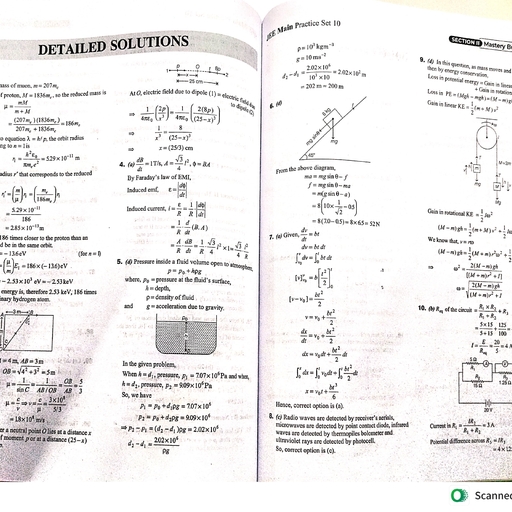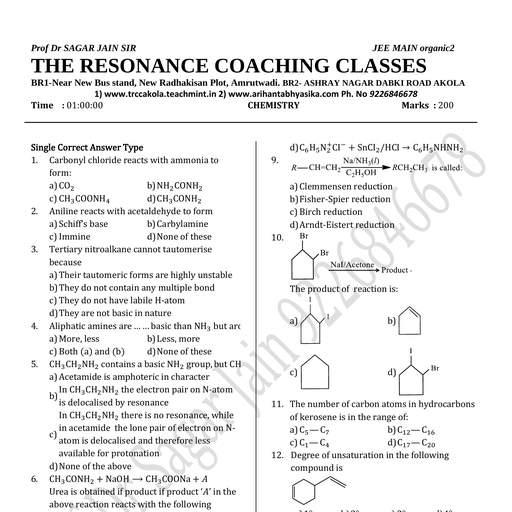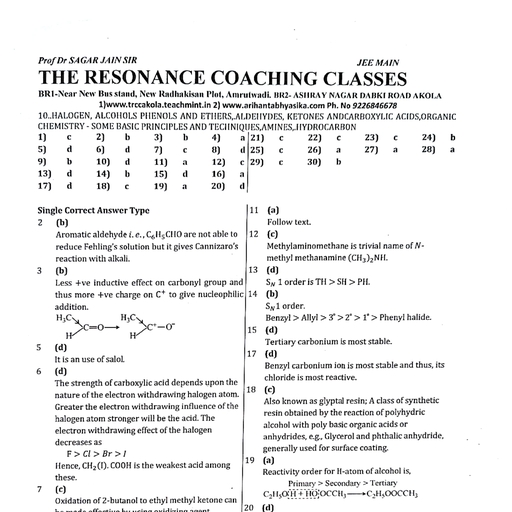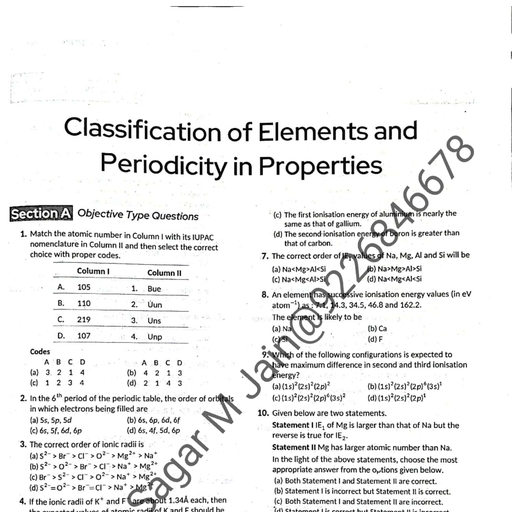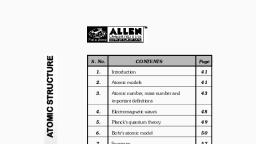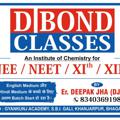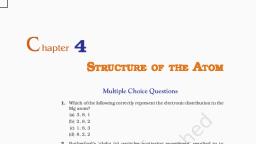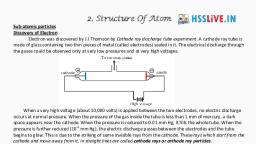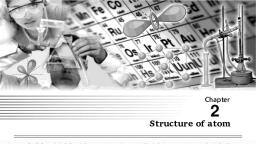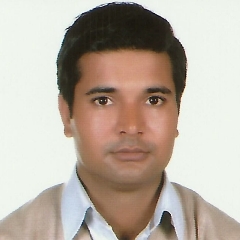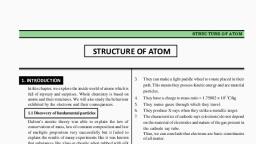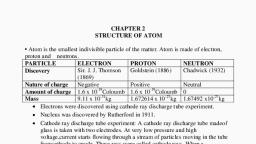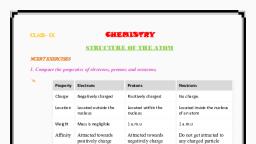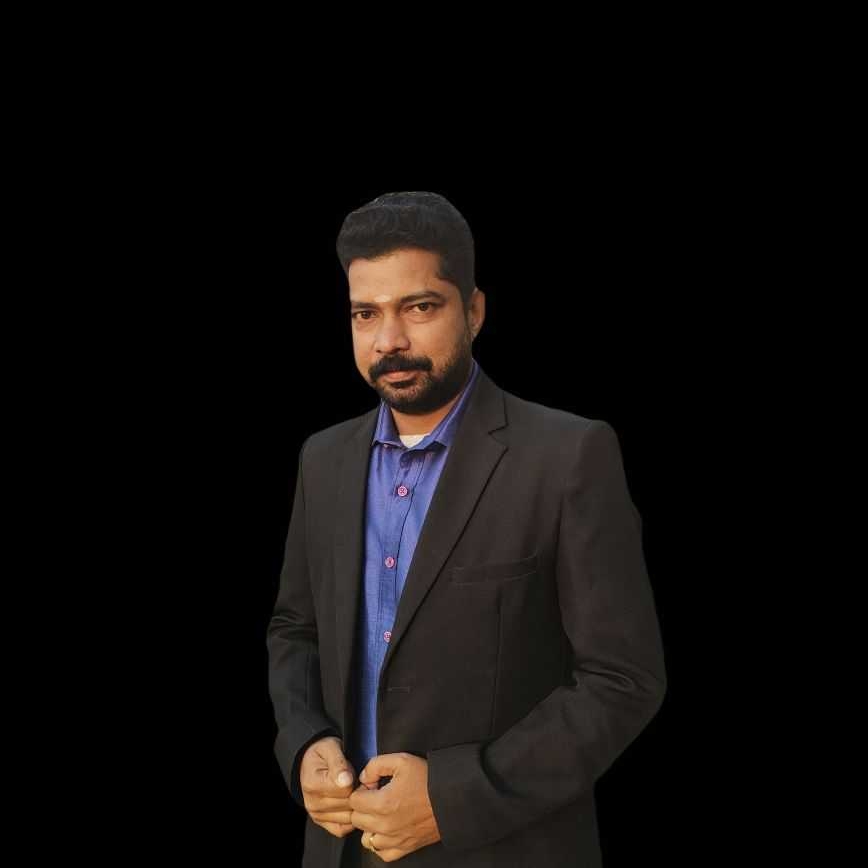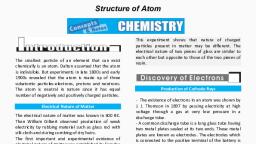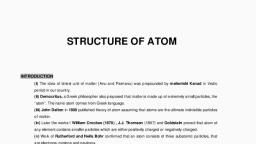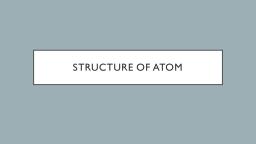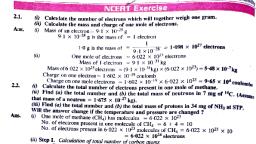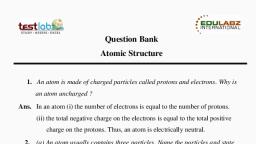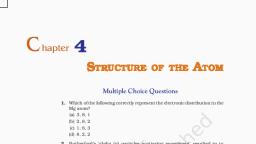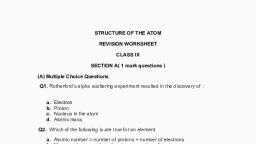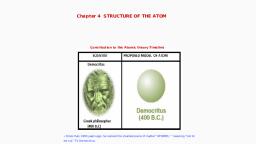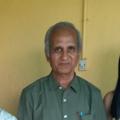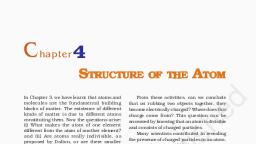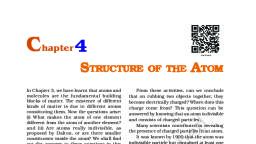Page 1 :
2.2, , 37. The number of electrons in a neutral atom of, an element is equal to its, (A) atomic weight, (B) atomic number, (C) number of neutrons, (D) none of these, , , , Atomic number and mass number =
Page 2 :
38., , 39., , 40., , 41., , 42., , 43., , 45., , 46., , -@) _ four protons and two electrons ——., , The atomic number of an element Tepresent,, [CPMT 1983; CBSE PMT 1999,, NCERT 1973; AMU 1984), (A) number of neutrons in the nucleus, (B) number of protons in the nucleus, (C) atomic weight of an element, (D) valency of the element, , Which of the er always a whole, number? e PMT 1976, 81, 86], , (A) Atomic weight — «, (B) Atomic radii, , (C) Equivalent weight, (D) Atomic numbet=—=, , The atomic number of an element is always, equal to . [MP PMT 1994) 1, (A) atomic weight divided by 2, , (B) number of neuter in the nucleus, (C) weight of the m S, , (D) electrical chargé bf the nucleus, , The equation relating the characteristic, frequency (v) of X-réy-emitted by the element, , and atomic number (Z) of the element given, by Moseley is, , (A) vv=a(Z-6)==B) v=a(Z-b), , (© v=2 2 v=a—(Zb), The number of el and neutrons of an, , element is 18 and 2 tespectively. Its mass, number is, , , , [CP! 997, Pb. PMT 1999,, MP PMT 1999], , (4) 17 @) 34) 2 @) 38, , The number of electrons, protons and neutrons, , in P* ion is reepesi :, , [Assam CEE 2015], (A) 15,15, 16 Se) 15, 16, 15, (C) 18,15, 16 ) 15,16, 18, Number of protons, trons and electrons in, the element gpX”* is’, , (A) 89,231, 89 (B) 89, 89, 242, (C) 89, 142, 89 (D) 89,71, 89, , Number of neutrons in C!? js ., A 6 8) 7 © 8 @ 122, , The nucleus of helium contains ., [CPMT 1972; DPMT 1982], , (A) four protons, , (B) four neutrons, , (C) two neutrons and two protons
Page 3 :
47., , 48., , 49., , 50., , 51., , 52., , 53., , 54., , 55,, , , , , , , , , , The difference between U5 and U23#, that U* contains, , (A) 3 more. protons, , (B) 3 more protons and 3 more electrons, , (C) 3 more neutrons and 3 more electrons, (D) 3 more neutrons, , atoms is, , The nucleus of the element having atomic, , number 25 and atomic mass 55 will contain, ICPMT 1986; MP PMT 1987], , (A) 25 protons and 30 neutrons, , (B) 25 neutrons and 30 protons, , (C) 55 protons, , (D)_ 55 neutrons, , If the atomic mass of an element is 23 times, that of the lightest element and it has, 11 protons, then it contains, , (A) 11 protons, 23 neutrons, 11 electrons, (B) 11 protons, 11 neutrons, 11 electrons, (C) 11 protons, 12 neutrons, 11 electrons, (D) 11 protons, 11 neutrons, 23 electrons, , The hydride ions (H}) are isoelectronic with, [AFMC 1995; Bihar MEE 1997], , , , , , , , , 56., , 357., , 58., , 59., , x@, , Which of the following particles have more, electrons than neutrons?, , (A) C (@) F, , (Cc) OF (D) AI*, , Number of electrons in - CONH? is [AMU 1988], , (A) 22 (B) 24, , (C) 20 (D) 28, , Nitrogen atom has an atomic’ of 7 and, , oxygen has an atomic ber§8. The total, , , , number of electrons ii i ion will be, i e [Pb. PMT 2000], , (A) 8 S 16, , (C) 32 (D) 64, , atom of atomic mass 12, and ato y ber 6, the atom of atomic mass, 13 ic number 6, _ c, , > [NCERT 1971], contains more neutrons, , contains more electrons, , Compared ‘wit!, , (A) Li (B) He* & e(C) contains more protons, (C) He (D) Be (D) isa different element, Na’ ion is isoelectronic with : q Isotopes and isobars, [CPMT i354)—, (A) Lit (B) Me”* > 60. Isotopes have the same number of, (C) Ca2* (D) Ba* (A) _ electrons (B) nucleons, The ion that is ines fed co (©) neutrons (D) all of these, is 2 61. Two atoms are said to be isobars if s, (A) Nz @B i [NCERT Exemplar], (C) O03 we e O; (A) oe have same atomic number but, . . ifferent mass number, fa hs oes « structures from the (B) oe have - peeks of electrons but, . mM aad . iiferent number of neutrons, CH; H; 1, CH; (C) they have same number of neutrons but, [IIT 1993] different number of electrons, (A) Iand II (B) IandIV (D) sum of the number of protons and, (C) Iand I (D). Il, Hand IV Sees but the number of, ifferent, Which one of the following is NOT ., isoelectronic with O77 62. What is the cause of the fractional atomic, [CBSE PMT 1994] mass of elements?, (A) N* (B) F (A) Isotopes (B) _Isobars, (©) Tr (D) Na* (C) Nucleons (D) Electrons, The compound in which cation is isoelectronic 63. Tritium is the isotope of ., with anion is [UPSEAT 2004] [CPMT 2003], (A) NaCl (B) CsF (A) hydrogen (B) oxygen, (C) Nal (D) KS (C) carbon (@) sulphur, , , , a comntaatiam
Page 4 :
64., , 65., , 66., , 67., , 68., , 69., , 70., , 71., , 24 |, , 72., , 73., , mo, , The sum of the number of neutrons and protons, in the isotopes of hydrogen is, , (A) 6 (B) 5, , (© 4 (D) 3, , Which of the following isotopes is used for, treatment of cancer?, , (A) “K (B), (©) “Sr (D), Which of the following radioactive isotopes of, , carbon is used to calculate the life period of a, planet?, , C9, ity, , , , (A) ec (B) eC, , © Sc (D) none of these, ¢C and {'B are called, , (A) _ isotones (B) _ Isobars, , (C) _ Isotopes (D) none of these, The nuclei «Cand jN" can be described as, (A) _ isotones, , (B) _ isobars, , (C) isotopes of carbon, , (D) _ isotopes of nitrogen, , Which of the following groups of species is, , isotonic?, (A) C2N% oF? (By CM NSF” CO), @) «cn, , (C) 14 7N* gE?, The nucleus of tritium contains, , [MP 102], (A), , @), , , , , , 1 proton + 1 neutron, , 1 proton + 3 neutrons <, (C) 1 proton+0 neutroiK \, @) 1 proton + 2 neuttons, Chlorine exists i, and Cl-35 but é, indicates, , , , , , , , topic forms, Cl-37, mic mass is 35.5. This, i0 of Cl-37 and Cl-35 is, , approxi : [NCERT Exemplar], (A) 1: @B) 1:1, (C) 1:3 @) 3:1, , Distance between the consecutive crests or, trough is called :, , (A) amplitude (B) frequency, (C) wavelength (D)_ wave number, The electromagnetic radiation with the highest, , wavelength is, (A) ultraviolet, (C) x-rays, , , , (B) radio waves, (D) infrared, , , , 74., , 1S:, , 76., , 77., , 78., , 12.5 Releniony theory of radiation ”, , 79., , 80., , 81,, , , , Which is NOT an electromagnetic radiation?, , , , [RPMT 2000), (A) _ Infrared rays (B) X-rays, (C) Cathode rays (D) Gamma rays, The radiation with maximum frequency jg, [TS EAMCET(Engg.) 2015], (A) X-rays (B) radio waves, (C) UV rays (D) IRrays, , What is the approximate wavelength of the, radiation of frequency 1.2 x 10" per second?, , , , , (A) 2.5x10°A (B). «4.0% 104A, (C) 4x107A D) \3'6 x 10 A, The frequency of, . of light is, 12 x 10" sec"! Lunve number associated, with this light i :, , (A) 5x 10% (B) 4x 10° cm!, (C) (D) 4x 10% cm!, , aoe, , The of Planck’s constant is, 6: y** Js. The velocity of light is, , 0° m s'. Which value is closest to the, , elength in nanometers of a quantum of, ight with frequency of 8 x 10° s17, , fom (A) 5x 1078, , [CBSE PMT 2003], (B) 4x10!, , (C) 3x10’ (D) 2x10%, , , , Electron corpuscular nature is NOT connected, with :, , (A) diffraction phenomenon, , (B) photo electric effect, , (C) Compton effect, , (D) mechanical effect by cathode rays, , The energy of a photon is calculated by :, , , , (A) E=hv (8) h=Ev, © n=Z () B=, Vv, , Which one of the following is NOT the, characteristic of Planck’s quantum theory of, radiation? [AIIMS 1991], (A) The energy is not absorbed or emitted in, whole number or multiple of quantum., , (B) Radiation is associated with energy., , (©) Radiation energy is not emitted or, absorbed continuously but in the form of, small packets called quanta., , This magnitude of energy associated, with a quantum is proportional to the, frequency., , Q), , _ ——
Page 5 :
8B., , 85., , 86., , 87., , 88,, , , , , , , , . Choose the INCORRECT statement,, , (A) Every object emits radiation whose, predominant frequency depends on its, temperature,, , The quantum energy of a wave is, proportional to its frequency,, Photons are quanta of light,, , The value of Planck constant is energy, dependent,, , (B), , (©), (D), , Which of the following is CORRECT, according to Planck’s quantum theory?, , , , (A) Energy is emitted or absorbed, discontinuously,, , (B) Energy of a quantum is directly, Proportional to its frequency,, , (C) A photon is also a quantum of light., , (D) Allof these, , The energy of a 700 nm photon is, , (A) 1.77eV (B) 2.47eV, , (C) 700eV (D) 3.57eV, , In photoelectric effect, the number of photoelectrons ejected is proportional to, , (A) _ intensity of incident beam, , (B) frequency of incident beam, , (C) wavelength of incident beam, , (D) velocity of incident beam, , metallic plate is halved, the K.E. eo, , photoelectron will be :, (A) halved ©, (B) doubled, , (C) unchanged, (D) _ increased more th: le :, , electrons from the, whereas orange light, , Violet light can ef, surface of a m, , cannot becausi ., , (A) the is of violet light is greater, th f orange light,, , (B) the wavelength of violet light is greater, than that of orange light. ;, , (C) the frequency of violet light is greater, than that of orange light., , (D) none of these, , According to photoelectric effect, the kinetic, , , , When the wavelength of incident oh, , , , 89., , 90., , 91., , Which of the following options represent the, CORRECT graph for photoelectrons?, (A) (B), , KE, KE, , , , Light intensity, v, , (C) Both the above, , Light of wavelength A strikes a metal surface, with intensity X and the | emits y, electrons per second of averdag ergy Z. If X, , is halved, then,, (A) ywill be halve Swte doubled, , (D) None of the above, , (B) y will be dou! ill be halved, (C) ywill be »Z will remain same, 7 will the same, Z will be halved, , the photoelectron from metal in the, , effect experiment can be stopped, ing 0.5 V when the radiation of, is used. The work function of the metal, , , , , , Ps [JEE (Main) Online 2018], SH 4ev (B) 4.5eV, e () Sev, , , , , 93., , 94,, , 95., , (D) 5.5eV, , The electronic energy levels of the hydrogen, atom in the Bohr’s theory are called, , (A) orbits (B) orbitals, , (C) subshells (D) both (A) and (B), , In the Bohr model of an atom, an electron can, revolve around in orbits known as, , (A) _ stationary circular orbits, , (B) _ stationary elliptical orbits, , (C) radiating circular orbits, , (D) radiating elliptical orbits, , When an electron revolves in a stationary orbit, , then « [MP PET 1994), (A), , (B), , , , it absorbs energy, , it gains kinetic energy, , (C) _ it emits radiation, , (D) _ its energy remains constant, , An electron in a Bohr’s stationary orbit can go, to a higher stationary orbit, , energy of the ejected electrons is directly (A) _ by emission of electromagnetic radiation, Proportional to é (B) without any absorption or emission of, (A) wavelength of ligh . electromagnetic radiation, , (B) intensity of light (C) with absorption of electromagnetic, (C) frequency of light radiation of a particular frequency, , (D) velocity of incident radiation (D) none of these













